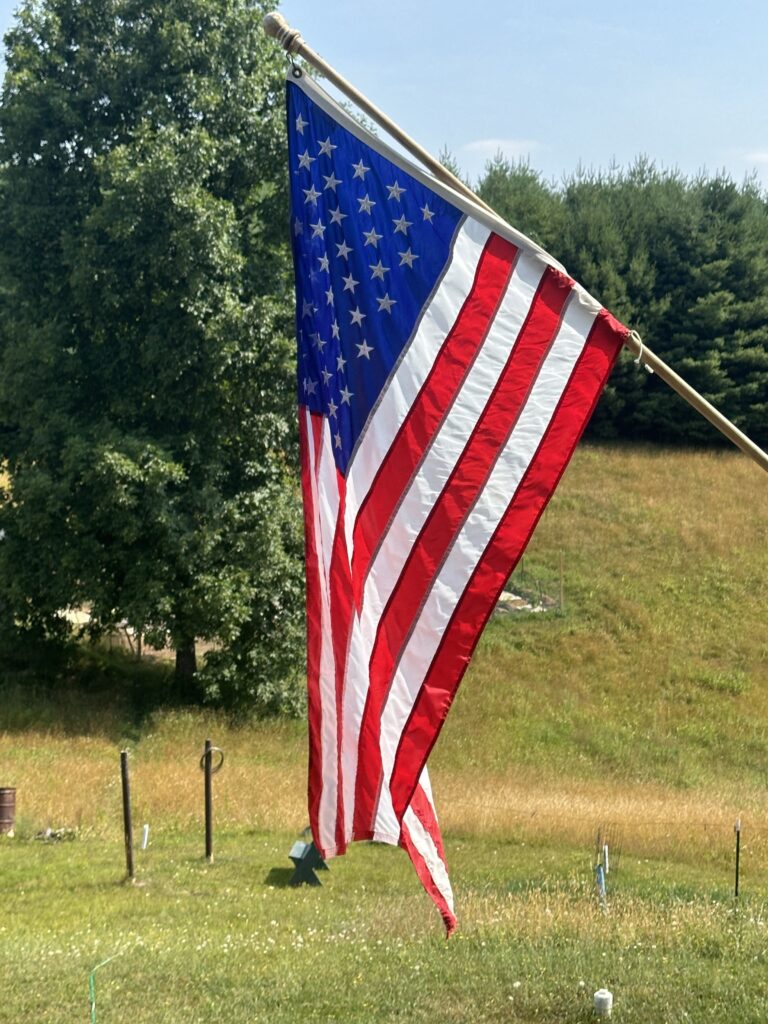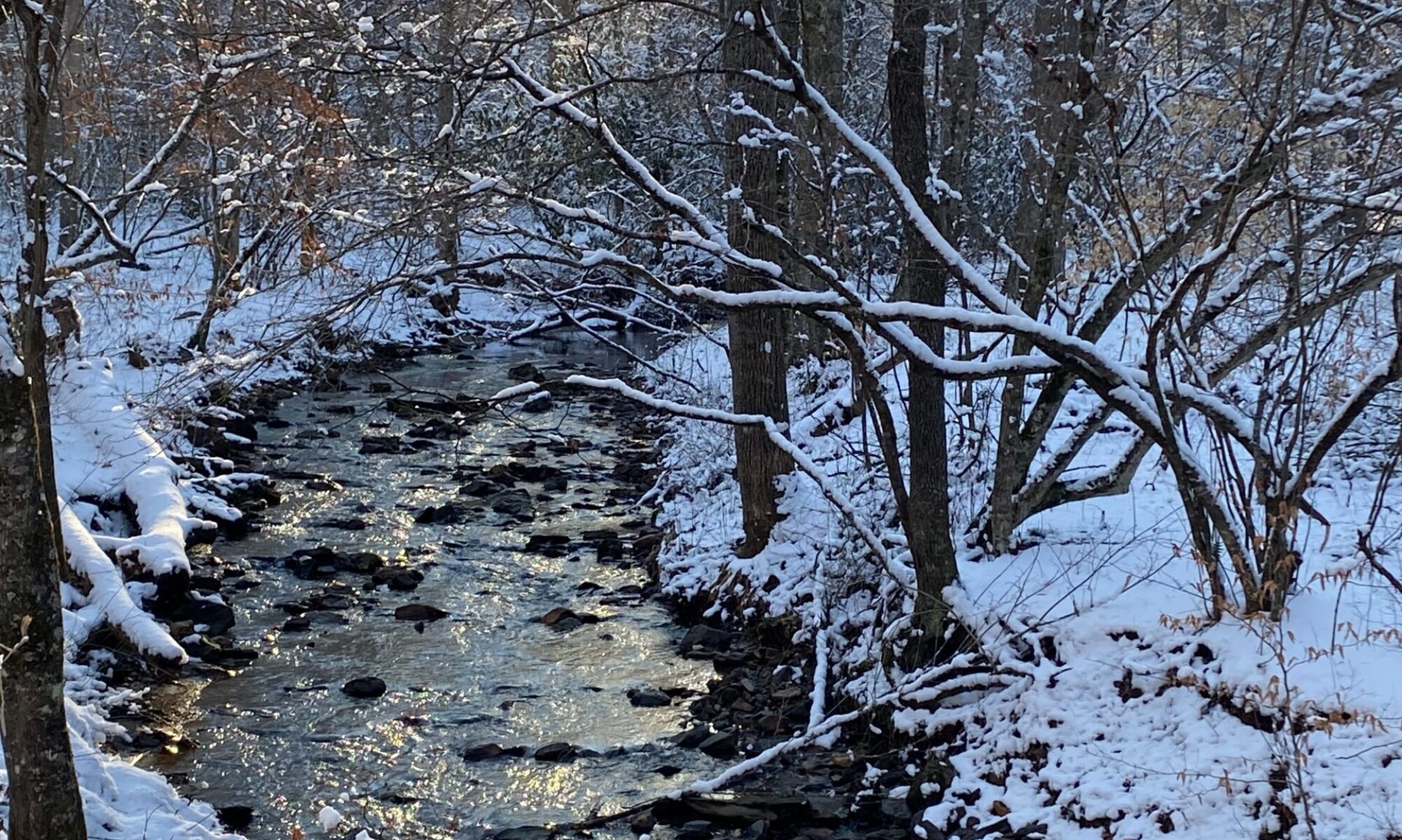
Happy Fourth of July everyone!
This past winter, I took an introduction to Amateur Radio class. In March, I took the exam for my Technician license. It had been almost 50 years since I had held such a license. In May, I passed the General license and am now studying for the Extra Class.
I’ve been dipping my toes into the world of radio, using a small 5-watt handheld on 2 meters and 70 cm bands. These bands have a limited distance as the higher frequencies (VHF and UHF) don’t do the skipping off the ionosphere the lower bands do. However, thanks to repeaters last night I had a conversation with a guy in West Virginia, probably 75 miles from me as the crow flies. I have been assembling equipment and soon, once again, hope to listen for someone calling CQ from around the world on the high frequency bands. Here’s a reworked piece in which I share my early teenage experiences with amateur radio in the early 1970s.
My new license call sign is KQ4PVG, although I may apply for a vanity call sign and see if I can get a part of my old call sign (at least the YGY part) back.
I’m not sure all the reasons I got so interested in Ham Radio. Perhaps it was because I was small and there was little chance of me playing sports once I got to junior high. To compensate, I decided to excel at something else. Don Conaway, a man from our church, who only had daughters (and perhaps to compensate for that), offered to teach my brother and me about radios.
We started meeting in the evening, once a week, at his house. We’d begin sitting around his dining room table. First, we’d practice Morse Code for fifteen minutes. That was easy because I’d taught myself Morse code (and semaphore), due to spending too many days grounded in my room. After a code session, he’d pull out some paper and for another fifteen or twenty minutes, we’d have a math and drafting class, learning Ohm’s law, how to slice the PIE formula (determining power), the meanings of various electronic symbols, and the schematics of radio components.
After the classroom session, Mr. Conaway would take us out to his “shack,” a small white wooden building behind the house and next to a persimmon tree. I remember the latter for he tried to entice us to try a green persimmon, but we were no dummies. Later that fall, after a frost, we enjoyed a few of the ripe fruit.
The place was crammed with electrical parts and all kinds of radios and test equipment. Here, we learned the purpose of resistors and capacitors of which we’d drawn in our schematics and how to solder. In time, we built a power supply designed to take 110 AC current and, after running it through a transformer and a bridge built out of vacuum tubes which converted the power to the desired voltage and to DC current. Then we started building a transmitter, using a 6146 tube. When finished, this transmitter was able to produce 60 watts of power. It was a simple machine, utilizing crystals to control the frequency. This meant that if you wanted change frequencies, you had to pull out one crystal and replace it with another. He gave us three crystals, two in the 80-meter band and another in the 40-meter band.
That fall, around the time the persimmons were ripe, we took the exam. A few weeks later, I learned I’d passed and received my “ticket” (or license). It arrived in early December; about the time we’d finished building the transmitter. My ticket couldn’t have come at a better time as I wasn’t doing particularly stellar in school. It provided a bit of pride as I passed the exam before my brother, who had to retake the test.
My call sign was WN4YGY. The first three digits indicated nation (W for USA, esst of the Mississippi), class (N for novice) and 4 for the Southeastern part of the county. The last three digits (YGY) were unique to an individual. Mr. Conaway immediately came up with a phonetic rending of the last three digits of my call, “Young Girls Yell.” In more ways than one, I fondly look back on those days.

Soon afterwards, Mr. Conaway came over to our house and with our help, we installed an 80-meter ½ dipole antenna. As ½ of 80 meters is 40 meters (or around 130 feet), the wire stretched from a longleaf pine tree in our front yard to one in the back yard. The halfway point was just outside my bedroom window, and a piece of coax ran from the center of the antenna through the window and on to the transmitter and receiver. I started out with equipment borrowed from Mr. Conaway, but later would add our homebuilt transmitter along with a receiver I purchased.
My first contact was to Wayne, another young ham in Leland, NC who was my age. Leland was only across the river from us, but it was a contact. Even though Wayne went to a different school, we became friends. After we both received our driver’s licenses, we hung out together. As he was on North Brunswick’s High chess team. As my much larger school didn’t have such a team, I occasionally sparred with those on his team. We also did a fair amount of canoeing and hunting together during our high school years.
That winter, as the sun set, the 80-meter band came alive. The upper regions of the ionosphere strengthens in the cold darkness of winter. This allows the long wavelengths the capability of making great bounces, allowing my signal to be heard across North America and into Europe. Every day I’d rush home from school and be ready to be online as the sun set. It was exciting to hear that first “CQ” of the evening, a call from operator looking for someone with whom to chat. I’d tap out his call letters, followed by “de” (from) and my call sign. Soon, we’d be exchanging information about our location and age and the weather.
Although my brother (he’s now a mechanical engineer) eventually passed his test and received his ticket, the radio bug never really bit him. Maybe this was because I was always online, and we shared equipment. Since we also shared a room, it annoyed him when I crawled out of bed at 3 or 4 AM and pull on a headset and fire up the radio. No one else in the house could hear, but the lamp was a nuisance to him. Using CW (morse code) I enjoyed chatting to folks on the West Coast as well as in South America and Europe. Each new state or country was like a conquest. Over time the wall behind my radios were covered with QSL cards sent from other operators with whom I’d communicated..
The most exciting period during my time on-air was when an emergency net was called to relay messages from Central America. It was around Christmas 1972, the same Christmas which my friend Mark had been killed in a motorcycle accident. An earthquake had hit Nicaragua and for hours I monitored traffic for messages were coming to North Carolina. Although I never had traffic sent my way, I felt as if I was a part of something big, especially when I saw the devastation on the morning news. This was the same earthquake that my hero, Roberto Clemente, the slugger for the Pittsburgh Pirates, was killed in a plane crash while on a humanitarian mission. Death seemed to be all around me that year, but it was also enlightening to watch history unfold.
In time, I lost interest in the hobby. By the time I graduated from high school, I was no longer spending time with the radio. At one point, I purchased a used low power transceiver. I got it up and running using 2 watts from a six-volt battery. Using a portable long-wire antenna, I could take this unit camping with me. But I lost interest and boxed it all away. The radios I used seemed so modern at the time. But they, were really behind times as everything was shifting to transistors and diodes and eventually to pre-wired circuit boards. Sometime in college, I gave all my equipment to the man who had helped me earn my licenses. By then I was into other hobbies.


Though I never had or operated a ham, we did have a CB radio in our Cutlass when I was a kid. Trying to remember my parents’ “handles,” but they escape me at the moment.
Also working at a radio station at 17, I remember in those early years getting weather reports across the teletype. A lot of times during stormy weather, you’d see things like “funnel cloud spotted by ham radio operator.” I think they were the first storm chasers… or maybe just storm spotters/reporters.
I’ve always found CB radio fascinating! It must be so cool to talk to people across the ocean or on the other side of the country. Learning Morse Code is one of those things on my “someday” list :p
That sounds fun. Happy 4th to you.
Why is it ham radio, and not filet mignon radio. Asking for a friend 😆 I’d love to get into this someday.
Filet mignon is a mouthful. Ham is only seven taps on key (morse code) compared to 22 for Filet migon. With your electrical background, you shouldn’t have a problem with the theory (at least for the Technician class, the General and Extra classes deal a lot more with radio waves and less with Ohms law and power formulas)
Our organist in Atlanta, Jim Wingate, is a ham radio operator. He also taught computer science at one of the elite private schools.–needless to say, VERY talented. During 9-11 he went to NYC and helped out since communication among responders was critical.
There’s a pretty active group in Hillsville that travels around to provide disaster communications.
I think it’s fun that you’re getting back into this. Are there many ham radio operators now? My dad (who died when I was 11, so I don’t remember a lot) owned and managed a commercial radio station, and I think he might done something with the Signal Corps in WWII in the Pacific. I’m just not sure. I never got beyond a CB radio! My handle was “sunspot”. ,
Sunspot? A heavy sunspot cycle could help the CB bands to have more skip contacts!
Happy July 4th to you!
And to you, Jacqui!
I never got into ham radios but growing up on a farm, I used a lot of citizens band radios.
My only CB radio was a walkie talkie that my brother and I both received for Christmas in 1965 or 66. We used to use them to talk to each other.
Great piece, Jeff. Mr. Conaway sounds like a great teacher.
While that wasn’t his vocation (he worked as a civilian at Fort Fisher and then for the FAA, working on radars), he was a good teacher